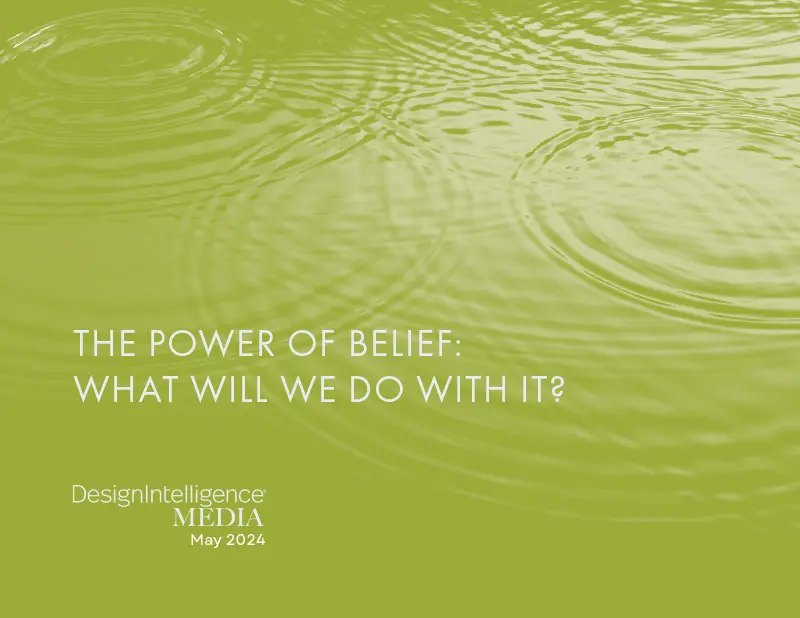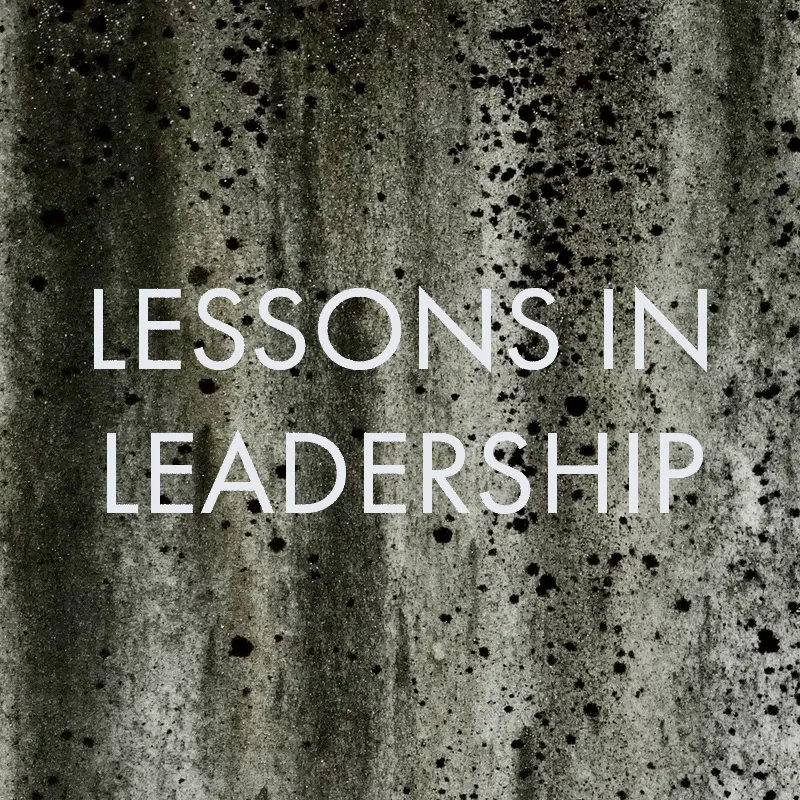
The Power of Belief: What Will We Do With It?
Michael LeFevre
Managing Editor, DesignIntelligence
May 29, 2024
DI’s managing editor looks at unconventional sources in search of conviction.
In 2023 I came to an understanding of one of the world’s most powerful forces: the power of belief. Yes, I’ve come to understand that this power is one of the most amazing forces in the world. With your permission, I’d like to share this understanding. To build common ground, I’ll start with some self-disclosure: I’m a University of Michigan football fan. I earned two degrees there, taught there, served on the alumni board there, tried out for the hockey team there and our daughter got her master’s degree there. I love the place unabashedly. It served me well in providing an education, a community and a cause I believe in. In my case, that cause was architecture — or shaping the built environment. In the 2023 season the Michigan football team achieved great heights. In January 2024, they won the national championship, the pinnacle of their sport, after an undefeated season. Much has been written about their journey and an analysis of it holds the potential to enlighten and activate leaders, people like us: designers, builders and operators of the built environment.
The Cult
During the fall 2023 football season, the Washington Post published an essay entitled, “I’ve been brainwashed by the most powerful cult ever: Michigan football” (https://www.nytimes.com/2023/12/31/opinion/michigan-football-rose-bowl.html?mwgrp=c-mbar&smid=em-share.)
Reading this article caused a friend to comment, “This is a cult!” My response? Darn right (per the Washington Post!), and I’m a proud member. Concurrently, another friend forwarded me the same article along with his observation: “Perhaps this is what it feels like to be in a powerful, all-consuming religious or political cult?” I’m quite sure he was right — because I’ve lived it.
Adversity Solidifies Belief
In this storybook year for the Michigan football team, its journey and its followers came under attack for a series of scandals, each of which has been brought into focus by non-members of the Michigan football “cult.” These allegations suggest that technical lines may have been crossed, including a rogue staff aide named Connor Stallions who surreptitiously filmed opponents’ signs; a recruiting “violation,” namely buying a potential recruit a hamburger at lunch; and other offenses. Only time will tell the degree of these violations. The sign-stealing rule has since been eliminated by the NCAA in favor of wireless helmet communication. Nevertheless, the players did not commit them and remained dedicated to their cause. Suspension of the team’s head coach, Jim Harbaugh, followed.
Through all these challenges, the team prevailed, because each of these obstacles only brought them closer. Simply put, because of their belief in their common mission, these challenges served to build strength and unity among the team and strengthen their conviction. They continued to win against all odds.
As evidence of the power of their common belief, in countless interviews throughout the year, to a person, the players and coaches spouted the same mantras:
- “Q: Who’s got it better than us? A: Nobody!”
- “Attack each day with an enthusiasm unknown to mankind!”
- “Just get better tomorrow than we were today!”
- “Michigan versus Everybody!”
- “Michigan versus the World!”
These clichéd slogans became clear representations of the team’s common belief in one another and in their mission. As someone who thinks for a living, I bemoan their mindless, repetitive simplicity while simultaneously marveling at their power.
The Michigan coach has long been acknowledged as quirky and flaky, but the fact is, in his creation of a common belief through these sayings and his actions, he is effective. A leader. And he finally turned the tide, slaying the demons of SEC football by defeating the likes of the Alabama dynasty and sending his team and their followers to the highest level, to the delight of thousands of followers worldwide.
When I observe interviews with Coach Harbaugh, despite my own deep belief in the team, the program and the culture, his responses cause me to wonder: Is this man even possible of conceiving an original thought, or does he simply regurgitate football clichés?
But it doesn’t seem to matter. The power of the common belief he created and instilled among his culture and his charges, and the millions of alumni followers, is immense and frightening. In parallel ways, it’s akin to the more serious beliefs held by soldiers who fight for our freedom. Such belief yields more than articulating a common cause. It induces young people in their prime to work, exercise and devote their lives to their cause. Granted, successful realization of the belief comes with giant rewards for some through name, image and likeness (NIL) fortune and fame. It can help propel athletes to the next professional levels. For those who care, even to prominence in national media. The TV and media money that drives these entertainment industries is scary indeed. So is the allure of lucrative, life-changing NFL contracts for a few top draft picks that emerge from the college ranks. Such outcomes change the lives of those who achieve them. They enable players to buy homes for their parents, who in many cases raised them in single-parent households. It also helps them realize the trappings of the rich. Many choose to give back generously and use their power and fortunes for good. Sadly, just as many squander their success, ending up penniless despite it all.
The built environment professions should be so lucky as to wield so much capital and use it for good purposes. But truth be told, we do wield much money and power — 40% of the world’s GDP, they say. It’s just that too often we misdirect it and forget to deploy it collectively for greater impact. Perhaps we are less effective in our creation of belief and conviction?
Since winning the championship, to no surprise, Coach Harbaugh has moved on to a new position in the NFL. Having achieved his mission, he is driven to create new belief and conviction at the professional level. He is, it seems, a man driven by creating conviction and belief. Are we?
The dark side of these kinds of strong belief systems is that they can be directed for evil purposes. To my friends’ question of cults, we find evidence in certain political factions in modern times, in World War II and in plenty of other religious and political regimes. The message? Believer beware! Be careful what you believe in.
Dismissing Sports Analogies?
Many of you may have already disregarded this piece because the idea of football turns you off.
Scholarly types regularly disdain the topic as boorish. After all, who cares about a bunch of Neanderthal brutes trying to maim each other on the football field? It’s only a game. What can possibly be the value of people, passionate believers all, spouting ridiculous rallying cries such as:
- “Hoddy Toddy, Great God Almighty” (Mississippi).
- “Go Blue” (Michigan).1
- “Roll Tide” (Alabama).
- “Hook ‘Em Horns” (Texas).
- “Sic ‘Em Dawgs” (Georgia).
- (insert your school or organization here, proudly).
True, football is only a diversion, but its power to unite through common belief is informative. Acknowledging the great power of such data-compressed, loyalty-identifying slogans, perhaps we design and build leaders would do well to consider some similar mantras of our own to generate momentum? There is no question that we all already believe in architecture. We are in the grip of its cult. We live it and love it. But what often fuels that belief is the drive to change the profession for the better, along with its value proposition for our clients, constituents and selves. We see architecture so clearly. To us, its power is so obvious. Why don’t others see it as we do? To understand why, I offer a more scholarly, yet still-frightening personal anecdote.
The Gorilla in the Room: Task Blindness
For you football doubters, skeptics and dismissers, let’s look at another line of reasoning: the power of task blindness or task bias. Some 15 years ago, I attended the opening plenary session of the Society for College and University Planning’s national conference in Denver. Also, in attendance were some 5,000 master’s degree- and Ph.D.-holding educators, administrators and policymakers, along with architects and builders, America’s leadership in shaping and creating environments for institutions of higher learning. All incredibly smart people dedicated to a noble higher cause. Our plenary speaker that day gave us an assignment in his opening talk: Watch a short video and count the number of times that the team in white T-shirts (playing in a small elevator lobby) passed a basketball back-and-forth. The video played. “How many did you count?” asked our speaker. “25 … 23 … 27,” came the answers. “The correct answer was 27,” he explained. “But how many of you saw the man in the gorilla suit?” he asked.
Watch the video here at the Invisible Gorilla Experiment, University of Utah.
https://www.ksl.com/article/15204008/the-invisible-gorilla-reveals-human-brain-capacity.
When the crowd stirred and rumbled in disbelief, denying his claim, he reiterated his statement. “Yes, in fact, during the brief video you just watched, a man dressed in a gorilla suit, walked across the screen, stopped in the middle of the frame, beat his chest and exited the frame.” So, what’s the problem? The problem is that we didn’t see it. We were so focused on our task (looking for people in white T-shirts passing basketballs) that we didn’t even see the dark man in the gorilla suit. Shocking. Frightening. All of us highly educated, highly confident leaders in the room — thousands of us — would have argued that this never happened. Yet it did. And after a few post-presentation cocktails, we did in fact argue and discuss this different understanding of the same reality and how frightening it had been. Before he showed us the proof, a few of us might even have been willing (fueled by those cocktails) to step outside and resolve the dispute physically. Fortunately, we did not. We had fallen victim to task blindness, being so over-focused on our end goal that we had blurred our own senses and abilities to receive and process sensory information with clarity and accuracy.
Dedicated to our lives’ work designing and building facilities for higher education and our own paradigms, life experiences, education, beliefs and confidence levels, we believed what we saw. We believed it to be factual. These were facts (so we thought), data entered into our minds. We saw them with our own eyes. We processed them. They were true. There was no other possible answer. But we were wrong. The frightening part about the power of belief is to consider how often — in our world of extreme polar political discourse and an ever-complex universe of data to process and understand — do we take in data and believe it when it is wrong? Consider this in the context of our current media and political climate.
Quite often I’m afraid we don’t take the time to listen, look and process more thoroughly. When we don’t take the time to question or are compelled by automatic filters, being driven by focus or task blindness, we forget to even consider the perspective of others — others whom we may be dismissing solely by our default biases as absolutely incorrect.
If, as leaders, we can convince ourselves and our followers of our common cause and its righteousness, we can accomplish damn near anything.
Questions
At this point you might ask: What do these personal anecdotes have to do with the mission of DesignIntelligence and yours as design and construction leaders? Only this: They demonstrate the power of belief. If, as leaders, we can convince ourselves and our followers of our common cause and its righteousness, we can accomplish damn near anything.
All of it makes me wonder, in our task-blinded love for architecture and the built environment, are we missing the point? Perhaps we should learn to look and listen to a broader set of influences to be more effective in convincing our clients, partners and constituents to love design as we do and achieve a nobler set of outcomes?
- If so, the questions become:
- What do we believe?
- What will we do with such immense powers?
- What can we accomplish together?
- Can we write the wrongs of the past centuries of the design and construction professions?
Specifically:
- Can we continue to reshape a profession that has been embarrassingly low in diversity, equity and inclusion? Current leaders are making great strides as women are being elected president of the AIA and their own firms, but can they move us beyond awareness and having a seat at the table to true action and results? We all hope so. We men have had our turn. It’s time for new leadership and belief.
- Can we use the power of belief to define the roles for our profession? Roles that transform mere ego fulfillment, and form making of art and sculpture for the luxury class to achieve real impact for the less fortunate.
- Can we reduce our impact on the planet?
- Can we transform our profession to become a desirable and more diverse one to continue to attract the kind of passionate professionals we need? A profession which offers value, return, profit, and rewarding roles to all and changes it from being long hours, and not enough time with our families for too little reward.
By harnessing the power of belief, I believe we can.
The questions remain.
As leaders, what do we believe in and what will we do about it?
On Conviction
Like the legions of long-suffering fans who continue to believe and follow their beloved sports teams through heartbreak and disappointment for decades, this essay’s success relies on conviction, the power of belief and the commitment to act upon it.
In the design and construction professions, leadership is about creating and instilling conviction among your firms, teams and those who work within them.
But how do we go about it? Such long-held, powerful beliefs are not arrived at quickly or easily. In sports, followers of baseball teams such as the Chicago Cubs, who live and die by their hometown heroes, have been indoctrinated over years by family and friends. Followers of soccer clubs in La Liga or Wrexham go to great extremes over years to support their teams. Taken to another extreme, political and religious beliefs are used to justify wars among countries. These beliefs are passed down over generations and centuries among families. Perhaps the convictions we should follow in the working world fall somewhere between these extremes. Passionate belief in a design direction or a set of firm values is important, but not a matter of life and death. Still, we earn our livelihoods and devote ourselves to our beliefs in the work we do. It gives us meaning, brings bread to our table and serves society in significant ways. But how do we accelerate building these beliefs when we don’t have decades? By leading, building culture and enlisting the whole organization.
“The worst speech you ever give will be better than the one you never give.”
- Peter Millar
So speak up. Care enough to share. Even my simple act of putting these words “on paper” is an example. Even at the risk of being incorrect, imprecise, ineloquent or indelicate, my decision to share these words demonstrates my conviction. I didn’t always have this conviction. For years, I was too timid, too busy or too something. Now, it’s my job to write and speak through my writing, but it’s only my job because I chose to take it on. I had the conviction to believe and to act. As a leader, creating conviction is your job too. But how? I may be a white male from the Midwest working alongside a woman of color, born in Asia, practicing the religion of Islam. Clearly, we are two people of different backgrounds, but we likely use our diversity to become richer and better in the workplace. But only if we share common convictions about that work. Are we trying to do the same thing? Do we believe in it, love it, hope for it, and are willing to work passionately for it? If so, with those common convictions, we will do great things together.
Leaders know how to create those common beliefs and convictions. They practice them themselves. They lead by example and are skilled at speaking and writing about their beliefs as they share them with others. Do you?
Perhaps we can learn from those who toil on playing fields in our quests to instill the powers of belief, hope, and faith in our teams at work. How wonderful and powerful it is when we can harness such common belief, common values and trust in one another - even approaching cult-like conditions - in our organizations. We simply must have conviction in the “right” things.
Perhaps our beliefs and sayings won’t be as simple as those of a football team. Certainly, they will be different for each of us. But I remain in awe of the power of such beliefs and the conviction to act upon them as I continue my search for commensurate actions.
Do you believe? In what? Here’s to trying, to believing … and to doing. Because, far beyond having beliefs, practice - and life - are about having the conviction to do something about those beliefs.
Footnotes:
1 The power of these sayings is pervasive and international. On a recent trip to Spain, I wore a packback emblazoned with Michigan’s block M logo. A man behind me enthusiastically proclaimed: “Vamos Azul!”
Michael LeFevre, FAIA Emeritus, NCARB, LEED AP is managing editor, DI Media Group Publications; principal, DesignIntelligence Advisory; and a senior fellow of the Design Futures Council. He is the author of Managing Design (Wiley 2019, an Amazon bestselling new release.)




